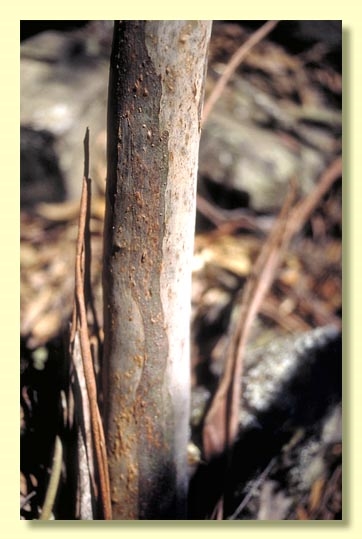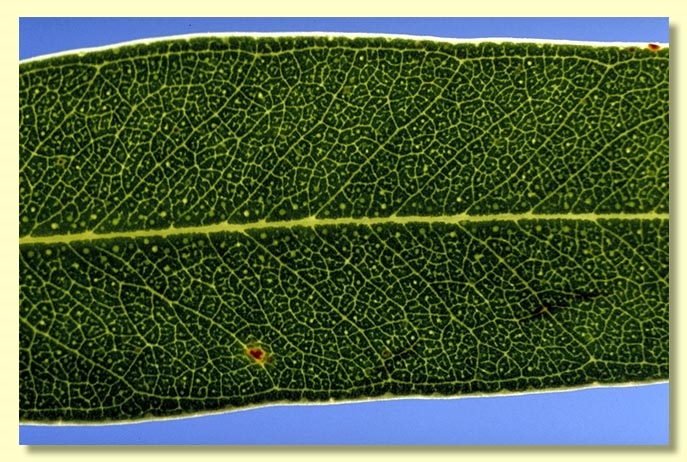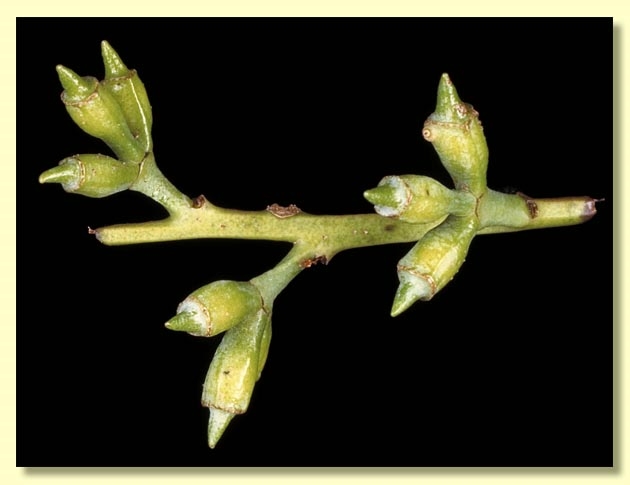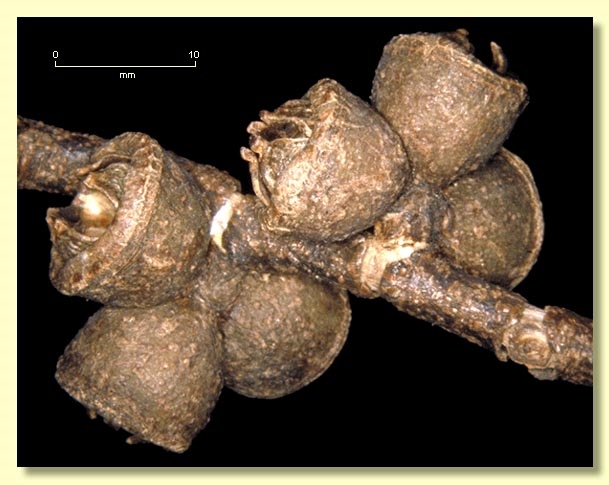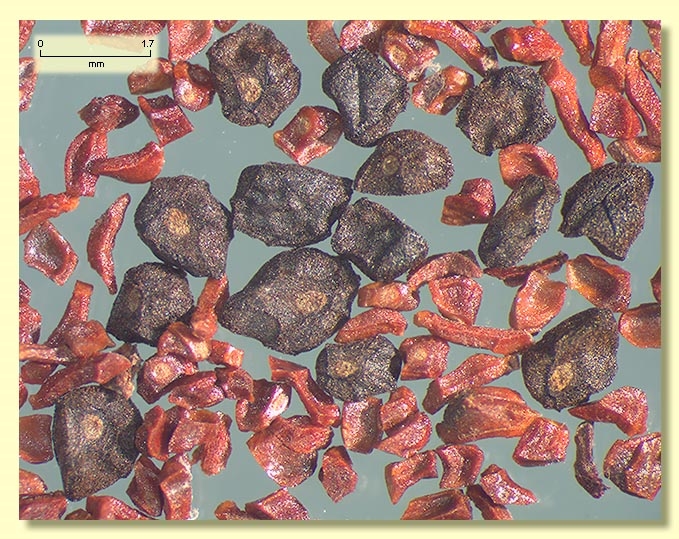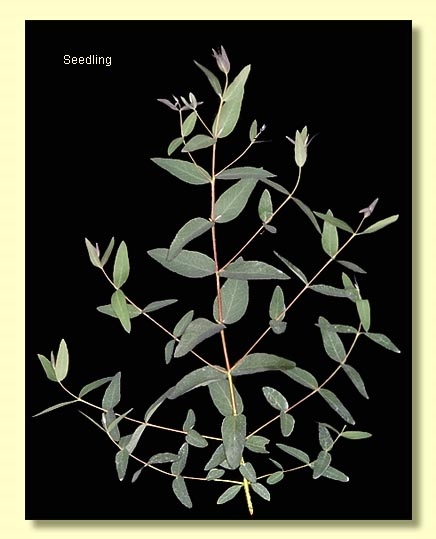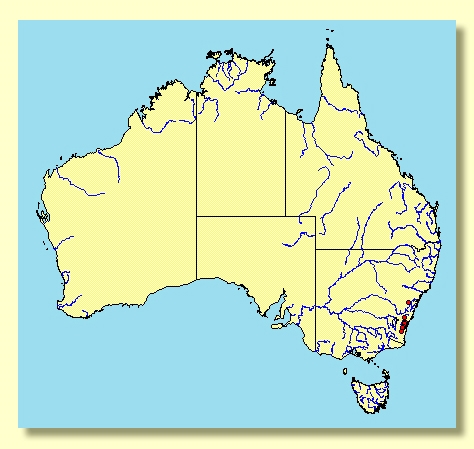Euclid - Online edition
Eucalyptus baeuerlenii
Eucalyptus | Symphyomyrtus | Maidenaria | Euryotae | Saxicola
E. viminalis var. baeuerlenii (F.Muell.) H.Deane & Maiden, Proc. Linn. Soc. New South Wales 26: 142 (1901).
T: Sugar Loaf Mtn towards sources of the Clyde R., NSW, 1890, W.Bäuerlen s.n.; holo: MEL; iso: K.
Bark smooth, pink, brown, grey, cream or green.
Juvenile growth (coppice or field seedlings to 50 cm): stem rounded or square in cross-section, warty or smooth; juvenile leaves opposite for 10 to 15 nodes, becoming alternate but often reverting for a few nodes, sessile or petiolate, lanceolate, 3.5–9.5 cm long, 1.3–2.8 cm wide, green or slightly grey-green.
Adult leaves alternate, petiole 0.5–1.8 cm long; blade lanceolate to falcate, 7–17.5 cm long, 0.6–3 cm wide, base tapering to petiole, concolorous, glossy or dull, green, side-veins greater than 45° to midrib, moderately to densely reticulate, intramarginal vein parallel to and just within margin, oil glands island and intersectional.
Inflorescence axillary unbranched, peduncles 0.2–0.5 cm long, buds 3 per umbel, usually sessile, rarely with pedicels to 0.2 cm long. Mature buds oblong to fusiform, 0.7–1 cm long, 0.4–0.6 cm wide, green to yellow, usually warty, slightly angled, scar present, operculum beaked to conical, stamens inflexed or irregularly flexed, anthers cuboid to oblong, versatile, dorsifixed, dehiscing by longitudinal slits (non-confluent), style long, locules 3 or 4(5) each with 4 vertical ovule rows. Flowers white.
Fruit sessile (rarely pedicel 0.1 cm long), campanulate, cup-shaped or obconical, 0.5–1 cm long, 0.8–1.2 cm wide, disc usually level or slightly raised, valves 3 or 4(5), strongly exserted.
Seeds dark grey to black, 1.5–2.5 mm long, ovoid or flattened-ovoid, lacunose, dorsal surface shallowly pitted, hilum ventral.
Cultivated seedlings (measured at ca node 10): cotyledons bilobed to oblong; stems square in cross-section, warty; leaves sessile and opposite for at least 13 nodes, rarely fewer, ovate-lanceolate, 3.5–7 cm long, 1.3–3.5 cm wide, base rounded to tapering, green to grey-green.
Flowering has been recorded in March, April, May and September.
A species endemic to New South Wales of disjunct distribution in mountainous country from the Blue Mountains near Wentworth Falls, south to Budawang Range, Mountains of the Moon in Deua National Park and Queens Pound Ridge in Wadbilliga National Park.
Eucalyptus baeuerlenii is a small tree or mallee with smooth bark, narrow lanceolate green adult leaves, buds in threes and the campanulate fruit with slightly exserted valves. It is closely related to E. wilcoxii, which usually has similar habit and bark but smaller buds and fruit, narrower bluish green adult leaves and occurs in the southern part of the range of E. baeuerlenii. The taller forest tree E. badjensis has similar crown leaves and small campanulate fruit but differs from these two species in the hard kino-impregnated rough bark on the lower trunk and juvenile leaves sessile and opposite for many pairs.
E. baeuerlenii belongs in Eucalyptus subgenus Symphyomyrtus section Maidenaria, a large group of species more or less restricted to south-eastern Australia, characterised by bilobed cotyledons, simple axillary inflorescences, buds with two opercula, stamens with versatile anthers and flattened seeds with a ventral hilum. Within this section, E. baeuerlenii, with E. wilcoxii, form series Saxicola having smooth bark, juvenile leaves opposite for up to 10 nodes (rarely more), buds in threes, and montane rocky habitat.


